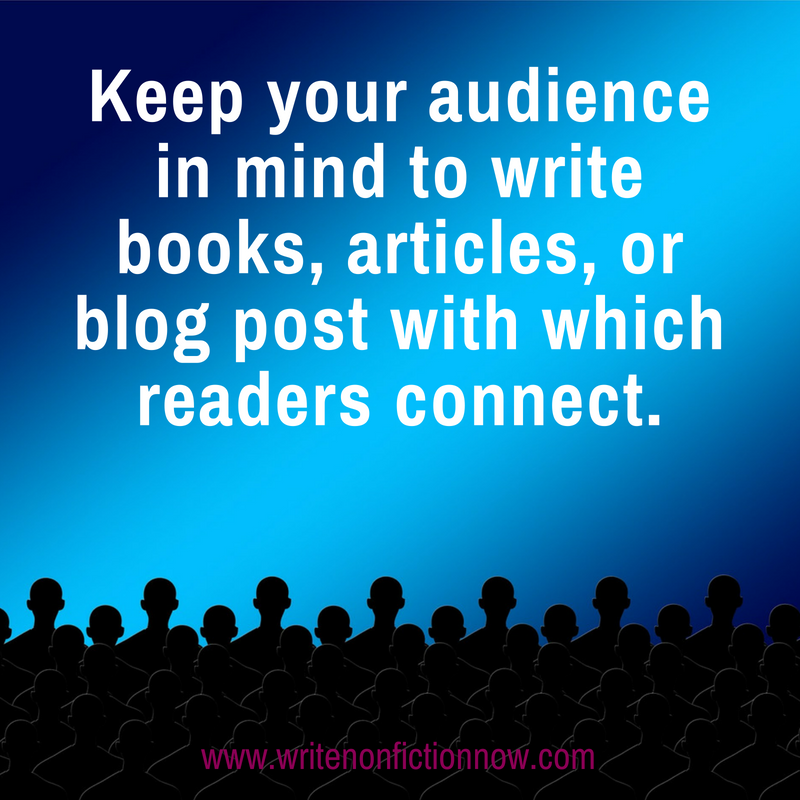Wednesday, July 18, 2018

You’ve heard the advice to “write for your reader,” but first you need to know who that person is. That’s why today book editor
C.K. Bush (
@theladyck) delves into the essential topic of finding the audience for your written work.
I hear one question often asked in my publishing work: “Who is the audience for this piece?” On the bookselling (and producing) side of things, we always ask ourselves this question. If a book has a definite audience, then surely we will be able to get that audience to buy it!
However, no matter the kind of writing at hand—a book, an article, or a blog post—it is as essential for the writer to think about their audiences as it is for their publisher to do the same. Writing that keeps the audience in mind is the most likely to connect with readers and have more of an impact. After all, who doesn’t like reading something that feels like it was created precisely with them in mind?
If a book has a definite audience, then surely we will be able to get that audience to buy it!Click To Tweet
The Audience Defined
What is “the audience”? In the simplest sense, it’s the community of people that will read your work. Yet, it is a community with very specific needs and wants.
You might think that everyone should read your work, but that doesn’t mean everyone will. To identify your true audience, think about whom is most likely going to benefit from your work. In the case of my post on this site, I consider my audience to be aspiring or new nonfiction writers. I’d like some of the established writers out there to be reading my advice, too, but I know from experience that they’re often not the type to go seeking writing advice from strangers. So, I calibrate my writing here accordingly.
In your own writing, you should begin with this assessment of your likely audience as well. If you want to reach someone far outside your likely crop of readers, you’ll need to think of clever marketing strategies to focus their attention on your work—but that’s a topic for another day!
Writing for Your Intended Audience
As I said, your intended audience is going to have its own needs and wants. Identify what those are so you can fulfill them. What’s the takeaway from your piece? What is the feeling you want readers to have when they finish? Is it meant to inspire them? Dispense sage advice? Make them laugh?
In my case, I know my audience wants to learn and improve their writing. Therefore, I aim to share (what I think is) wise advice, give some clear examples to help writers learn, and inspire hope for writers to go on practicing their craft.
Tone is very important in tailoring your work to your most likely audience. It wouldn’t serve any of my goals if I started my posts on this site with “Hey, losers! Think you’ve got what it takes to write?” By doing this, I would alienate my intended audience. Make sure to pick your words, your humor, and your examples carefully. Is your audience going to share your political opinions? If you’re not sure, best to leave any Trump jokes out of it. Is your audience going to be the same age as you? If not, best to avoid specific cultural references from your teenage years that they might not understand. Deliberate choices like these are vital in making your work appropriate for the intended audience.
Think about your unintended audience.Click To Tweet
Writing for a Contingent Audience
You’ve figured out your intended audience. Now you need to think about your
unintended audience. This is a group of readers that I believe fall into two categories: your critics and people you didn’t ever expect would find or read your writing. Ideally, your writing should be respectful of both of these groups.
When it comes to your critics, I mean people who generally might not agree with you or might see the issue from the other side. This can be anything from an obvious dissenter on a political topic or just someone who has a different idea of how to approach the topic of your writing. It’s important to think about what they’ll say and give it a fair acknowledgment in your writing. (I’m of the belief it should be done respectfully and subtly, too, without ad hominem attacks.) For example, I know some other writers or editors might have their own thoughts on the topics I write about here, so I’m always careful to mention these are my own opinions and to acknowledge common wisdom about writing when relevant.
It’s, of course, harder to determine what unknown readers, aside from the likely ones, will come across your writing. One safe bet, though, is that they might be people with no familiarity with the topic you’re discussing. To deal with this potential reader, I always recommend being as clear and jargon-free as possible. The typical test we editors will give our authors is the “grandma” or “mom” or (insert appropriate relative here) test—would they understand what you are writing? And if not, how can you adjust your prose to make it so that they will?
Another kind of unknown reader you may encounter is someone whose stake in your topic you haven’t yet considered. Often, this is someone whose reactions you might want to regard with sensitivity. As an editor writing an advice column for writers, for instance, I draw upon my own experience interacting with writers. But, I refrain from using specific examples from the nonfiction books I work on so that, in the off chance my authors stumble upon this site, they won’t find their works being criticized publicly. Instead, I invent examples or (in this case) use my own experience.
You may have these kinds of questions to grapple with, too. If you’re writing a memoir, is there someone who may feel offended by your depiction of events? If you’re writing a journalistic piece about a wrongful conviction, will the crime’s victims object to your take on why the conviction is wrong?
I am not saying you have to censor yourself or avoid honesty here but rather that you must responsibly and deliberately consider these audiences’ reactions as you write. You may even want to acknowledge the trickiness of the subject matter in your writing itself if warranted.
Coming to Peace with Your Audience(s)
Ultimately, understanding and acknowledging your intended and unintended audiences is a balancing act that all writers must undergo. Your work does not exist in a vacuum. Once you put it out there, it will have a life of its own.
Take the time and care to consider all the possible readers you may have and write in a way that addresses them. It might be extra work, but it’s a worthy step in making sure your work has the most impact.
Do you know who your real audience is? Tell me in a comment below.
About the Author
 C.K. Bush
C.K. Bush is a nonfiction editor and writer. She lives in New York City.
Photo copyright: geralt / Pixabay.com
The post
Finding and Writing for Your (Real) Audience appeared first on
Write Nonfiction NOW!.
Nina Amir, the bestselling author of How to Blog a Book and The Author Training Manual, is a speaker, a blogger, and an author, book, blog-to-book, and high-performance coach. Known as the Inspiration to Creation Coach, she helps creative people combine their passion and purpose so they move from idea to inspired action and positively and meaningfully impact the world as writers, bloggers, authorpreneurs, and blogpreneurs. Some of Nina’s clients have sold 300,000+ copies of their books, landed deals with major publishing houses and created thriving businesses around their books. She is the founder of National Nonfiction Writing Month, National Book Blogging Month, and the Nonfiction Writers’ University. As a hybrid author she has published 19 books and had as many as four books on the Amazon Top 100 list at the same time. Her most recent book is called Creative Visualization for Writers, and tomorrow her 19th book will be released, The Write Nonfiction NOW! Guide to Creativity and Flow. Find all her books at booksbyninaamir.com or find out more about her at ninaamir.com.